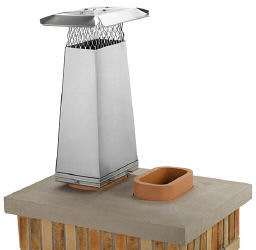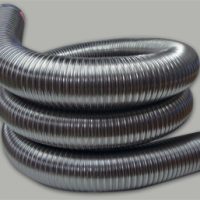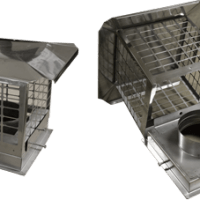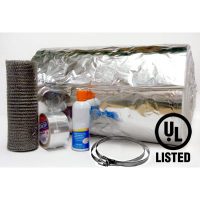Flue Stretcher Chimney Cap
A flue stretcher chimney cap not only protects the inside of your chimney but is also designed to protect the concrete crown area at the top of the chimney. and increase draft.
Why do I need a chimney cap?The most important reason for capping your chimney is to protect the inside of your chimney from water which can lead to moisture damage.
Capping your chimney will reduce the risk of burning embers or sparks from escaping the open chimney top and landing on your roof or in your yard.
An uncapped chimney is an open invitation to birds and animals to “nest” inside your flue. These “nests” block your chimney flue and can result in a chimney fire.
Flue Stretcher Cap
When you have two flues in one chimney flue may draw down the exhaust from the other flue into your home. What do you do?
Well, one quick and easy solution is to use a Flue Stretcher Cap. They come in sizes of 1′ or 2′. They simply allow you to in effect stretch one flue above the other far enough to prevent the cross over of flue gases. Flue stretchers come in both stainless steel and copper and will fit all the common sizes of flues. It’s simple, it’s easy, and it works.
the cross over of flue gases. Flue stretchers come in both stainless steel and copper and will fit all the common sizes of flues. It’s simple, it’s easy, and it works.
If you do not have a flue that extends beyond the concrete crown, call us and our custom shop can make a chimney cap that will mount to the crown.
By increasing the effective height of the flue the flue stretcher cap solves two problems.
- Negative house pressure can pull the smoke from one flue down another flue right beside it. Adding the flue stretcher to the upstairs flue distances its smoke from the downward pull of the downstairs flue.
- By putting the flue opening above roofs and other nearby structures you will improve draft and reduce down drafts.
How do I determine what kind of cap I need? Caps for chimneys come in many different styles and sizes. To determine what style is best for your application you will first need to know what kind of chimney you have.
If you have a masonry chimney determine next if you have a single flue or a multiple flue.
If you have a single clay liner sticking out of your masonry chimney, measure the top of the clay liner. These dimensions will determine what size cap will be needed.
If you have multiple clay liners or no liner at all, determine the dimensions for a multi-flue cap. The best way to immediately increase draft is by installing a flue stretcher chimney cap.






